Last Updated on September 22, 2023 by Mayank Dham
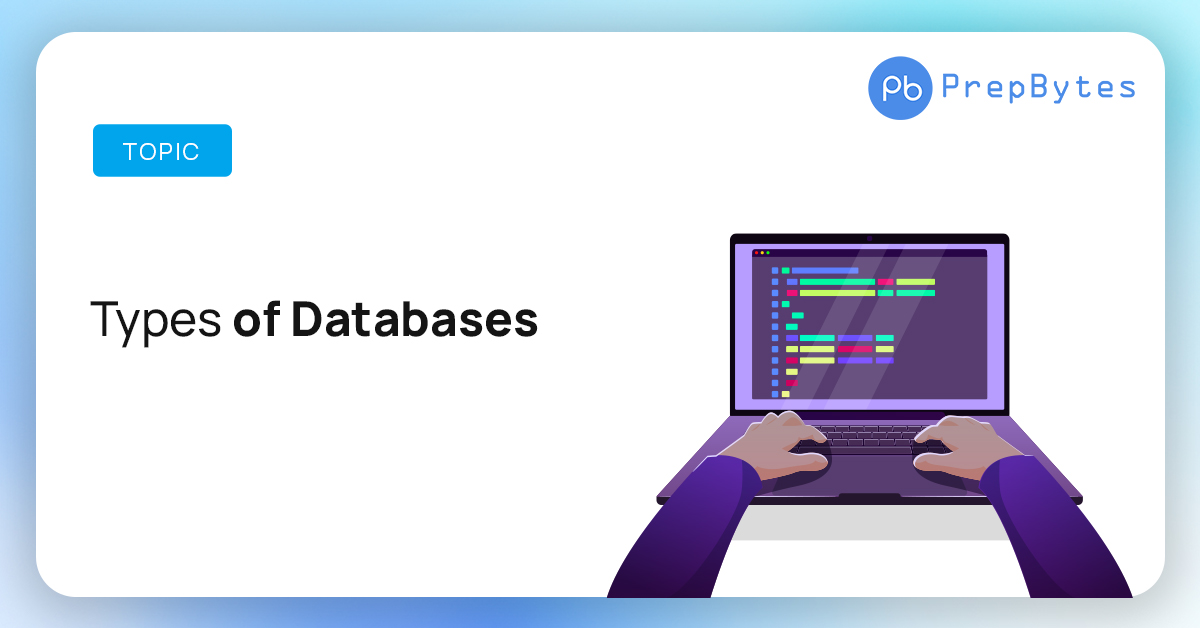
Organizations require databases to retain, manage, and refresh a range of data, encompassing details about staff and clients. The characteristics and storage capacity of each database are contingent on factors such as the volume of data a company must maintain, its user base, and the complexity of its data. To identify the most suitable database solution for a company, a comprehensive understanding of diverse database types is essential. Within this piece, we elucidate the concept of databases, explore their diverse manifestations, and showcase some of the top-tier database software options.
What are databases?
A database constitutes a collection of data stored within a computer system. It serves as a pivotal tool for individuals, including professionals, to manage records such as client information by storing data on their computers. Computers efficiently organize and store significant data within databases, enabling structured and easily searchable storage.
The many databases have evolved through time along with database technology. There are many different sorts of databases, and each has advantages and disadvantages depending on how it was made. Understanding the various databases is particularly crucial for organizations in order to guarantee the most effective setup.
What are the two primary database types?
The two primary types of databases are as follows:
- Single-file: Simple structures and individual files are used in single-file or flat-file databases to represent a single piece of data or information.
- Multi-file relational: Tables are used in relational databases, which are more complicated databases, to display the relationships between data.
Types of Databases
There are various types of databases used for storing different varieties of data:
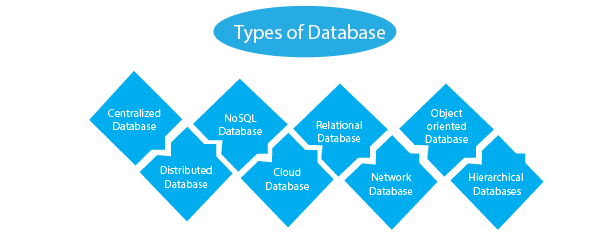
1) Centralized Database
It’s a particular kind of database that keeps information in a centralized database system. The ability to retrieve saved data through various apps from various places is convenient for users. The authentication mechanism is present in these programs so that users may access data safely. A Central Library, which maintains a central database of each library at a college or institution, is an example of a centralized database.
Advantages of Centralized Database
- The risk of data management has been minimized because the essential data won’t be impacted by data modification.
- As it handles data in a central repository, data consistency is preserved.
- Better data quality is provided, allowing businesses to set data standards.
- Because fewer providers are needed to manage the data sets, it is less expensive.
Disadvantages of Centralized Database
- The centralized database’s size contributes to a longer response time while retrieving data.
- Updating such a large database system is difficult.
- The loss of all data in the event of a server failure might be enormous.
2) Distributed Database
Data is dispersed among several database systems within an organization, as opposed to a centralized database system, in distributed systems. Communications connections connect these database systems. These links make it easier for consumers to obtain the data. Apache Cassandra, HBase, Ignite, and more distributed database examples are available.
A distributed database system can be further divided into:
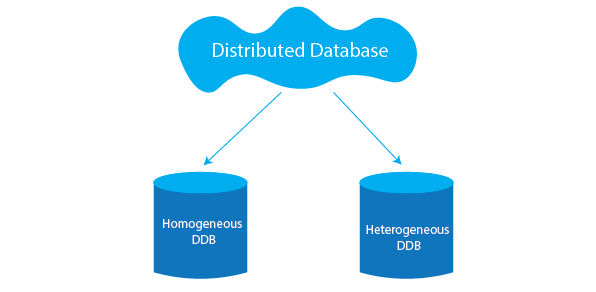
- Homogeneous DDB: Database systems that employ the same hardware components, the same application process, and the same operating system.
- Heterogeneous DDB: Those database systems that use various hardware devices and run under various operating systems and application processes.
Advantages of Distributed Database
- A distributed database allows for modular expansion, meaning the system may grow by adding more computers and connecting them to the distributed system.
- The entire data collection won’t be impacted by a single server failure.
3) Relational Database
The relational data model, which supports this database, stores data in the form of rows (tuples) and columns (attributes), which together constitute a table (relation). SQL is used by relational databases to store, manipulate, and preserve data. In 1970, E.F. Codd created the database. Every table in the database has a key that distinguishes the data from other tables. Microsoft SQL Server, Oracle, MySQL, and other databases are examples of relational databases.
Properties of Relational Database
There are following four commonly known properties of a relational model known as ACID properties, where:
A means Atomicity: This ensures the data operation will be complete either with success or with failure. It follows the ‘all or nothing’ strategy. For example, a transaction will either be committed or will abort.
C means Consistency: If we perform any operation over the data, its value before and after the operation should be preserved. For example, the account balance before and after the transaction should be correct, i.e., it should remain conserved.
I mean Isolation: There can be concurrent users accessing data simultaneously from the database. Thus, isolation between the data should remain isolated. For example, when multiple transactions occur at the same time, one transaction effects should not be visible to the other transactions in the database.
D means Durability: It ensures that once it completes the operation and commits the data, data changes should remain permanent.
4) NoSQL Database
Not only in SQL A variety of different data sets can be stored in a SQL database type. It is not a relational database since it stores data in a variety of formats in addition to tabular form. It was created as the need for creating contemporary applications grew. In order to meet the expectations, NoSQL offered a wide range of database technologies. The following four kinds of NoSQL databases can also be distinguished:
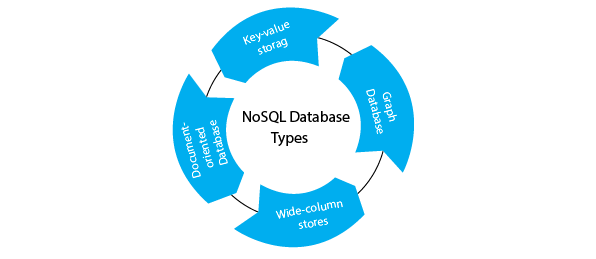
- Key-value storage: It is the simplest type of database storage where it stores every single item as a key (or attribute name) holding its value, together.
- Document-oriented Database: A type of database used to store data as a JSON-like documents. It helps developers in storing data by using the same document-model format as used in the application code.
- Graph Databases: It is used for storing vast amounts of data in a graph-like structure. Most commonly, social networking websites use the graph database.
- Wide-column stores: It is similar to the data represented in relational databases. Here, data is stored in large columns together, instead of stored in rows.
Advantages of NoSQL Database
- Since data storage in a structured manner is not necessary, it promotes high efficiency in application development.
- Large data sets can be managed and handled more effectively this way.
- It has a great degree of scalability.
- Through key-value, users may easily retrieve data from the database.
5) Cloud Database
a specific kind of database that runs on the cloud computing platform and stores data in a virtual environment. For database access, it offers consumers a range of cloud computing services (SaaS, PaaS, IaaS, etc.). There are several cloud platforms, however, the following are your best choices:
- Amazon Web Services(AWS)
- Microsoft Azure
- Kamatera
- PhonixNAP
- ScienceSoft
- Google Cloud SQL, etc.
6) Object-oriented Databases
The kind of database that stores data in the database system using an object-based data model approach. Similar to the objects used in object-oriented programming languages, the data is represented and saved as objects.
7) Hierarchical Databases
It is the kind of database that holds information as nodes representing parent-child relationships. In this case, the data is arranged in a tree-like pattern.
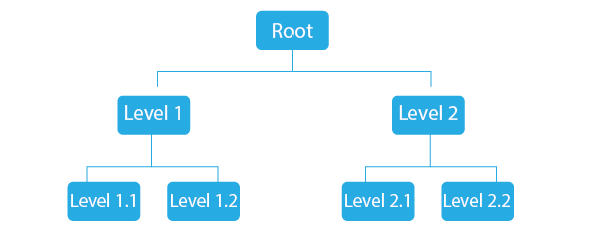
Records with linkages between them are used to store data. There will only be one parent per kid record in the tree. However, numerous child records can exist for each parent record.
8) Network Databases
The network data model is often followed by the database. Data is represented in this instance as a network of nodes that are linked together. It permits each record to have several children and parent nodes to construct a generalized graph structure, in contrast to a hierarchical database.
9) Personal Database
A personal database is defined as data that is gathered and stored on the user’s computer. Essentially, this database is made for a single user.
Advantages of Personal Database
- It is simple and easy to handle.
- It occupies less storage space as it is small in size.
10) Operational Database
The kind of database that is always being built and updated. It is primarily intended for use in carrying out and managing the routine data activities in various industries. For handling daily transactions, one company, for instance, employs operational databases.
11) Enterprise Database
This database is used by large businesses or organizations to manage enormous amounts of data. It aids in boosting and enhancing an organization’s productivity. Users can access the database simultaneously.
Benefits of an enterprise database:
- The Enterprise database supports many processes.
- It enables the system to process inquiries in parallel.
Conclusion:
This blog gives you detailed information of types of databases. We hope you understand the databases and the types of databases. Also, you can prefer our previous DBMS blogs for better understanding.
Frequently Asked Questions (FAQs) about Types of Databases:
Here are some of the
What are relational databases?
Relational databases use structured query language (SQL) and store data in tables with predefined schemas. They establish relationships between tables to facilitate querying and retrieval.
2.What is the difference between SQL and NoSQL databases?
SQL databases are relational and use structured query language for data manipulation. NoSQL databases, on the other hand, are non-relational and provide more flexible, schema-less data storage.
3.What is the advantage of using NoSQL databases?
NoSQL databases excel at handling large volumes of unstructured or semi-structured data. They offer high scalability and flexibility, making them suitable for dynamic and rapidly changing data.
4.What is a key-value database?
A key-value database stores data as a collection of key-value pairs. It’s highly efficient for simple and fast data retrieval but may lack complex querying capabilities.
5.What are document databases?
Document databases store data in a semi-structured format, usually using JSON or XML documents. They are ideal for handling unstructured or semi-structured data and are often used in content management systems.


